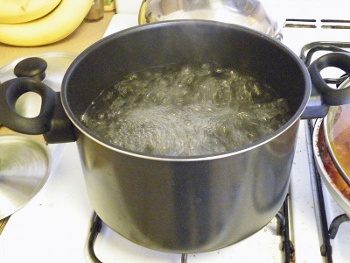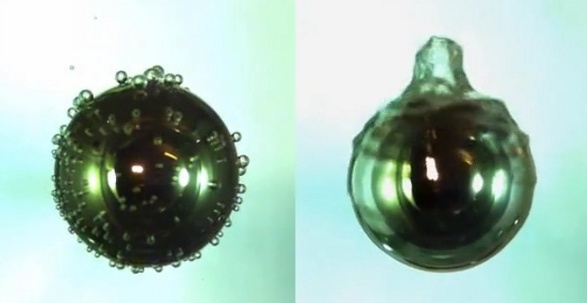Bubbles and Boiling
September 24, 2012
Every
chemist has used
boiling stones. These are small, irregularly-shaped bits of
inert material, and they are added to
liquids to act as
nucleation sites for
bubbles during
boiling. These provide a more uniform boiling of a liquid, and they prevent the large, burping bubbles that expel liquid from
beakers.
In
alchemical times, these were probably real
stones, but now they're just
ceramic pieces. It's important, however, to ensure their inertness, especially in the high
temperatures at which most boiling occurs. I'm sure that some chemists have been unable to
reproduce some
experiments, since they didn't consider the possible
catalytic action of
metals in the ceramics.

There's an old joke about the newlywed who was such a bad cook, she didn't know how to boil water.
The joke is still politically correct if we just say, "newlywed," and don't assume it's the woman.
(Photograph via Wikimedia Commons)
Cavitation is another way to make bubbles in a liquid. When a liquid is subject to a rapid
pressure change, as caused by
turbines and
impellers, bubbles will form and then
implode. The implosion is accompanied by forces that may cause
cyclic fatigue of the metal in contact with the liquid, so the usually benign bubbles become destructive. In my career in
industrial research, we were often asked for advice on cavitation problems.
Air, and other
gases offer
thermal insulation. That's the principle behind
insulating foams that contain air pockets, and the bubbles that form around a hot object will offer some insulation from the surrounding liquid. A bubble layer, however, has just a limited thermally insulating affect, since the bubbles are quick to detach from the object. Preventing the formation of bubbles would keep an insulating gas layer around an object, which would be useful in cases in which you wanted to thermally insulate an object in a liquid.
The insulating property of a thin,
vapor layer between a
solid and liquid, called the
Leidenfrost effect, was first noticed by the
German physician,
Johann Gottlob Leidenfrost in 1756, and it was subsequently named after him.
If a
droplet of
water is placed in a
frying pan just above the
boiling point of water, it will bubble and boil away rather quickly. However, if the pan is much hotter than the boiling point of water, an insulating vapor layer will form between the droplet and the pan, and there will be no boiling. The droplet resists
evaporation since the vapor barrier offers thermal insulation, and the water can't extract
heat from the pan at a rapid rate.
We can invert the problem, and instead have a hot object and a surrounding liquid. Things get complicated, fast, since we typically won't have
planar surfaces in contact with each other. Even if we do establish a stable vapor barrier layer at a very high temperature differential, when the object cools enough, the vapor film collapses below a critical temperature, and boiling will commence.
One possible approach to this problem is to modify the solid surface. In a
previous article (Tiny Droplets, March 6, 2012), I wrote about the evaporation of droplets from a nanotextured surface. Texturing a surface to make it
superhydrophobic favors the formation of suspended droplets with minimal contact to the surface, which promotes droplet shedding. This is complementary to the bubble problem in which we would like to inhibit shedding of vacancies in a liquid; that is, bubbles.
Surface modification to stabilize the vapor barrier was investigated by a team of
scientists from the
King Abdullah University of Science and Technology (Saudi Arabia),
Northwestern University, the
University of Melbourne (Australia) and the
Swinburne University of Technology (Australia). As reported in the September 13, 2012, issue of
Nature, bubble nucleation is inhibited when a surface is textured by a coating to make it superhydrophobic.[1-2]
In their experiments,
steel spheres were sprayed with a commercially available hydrophobic coating composed of
nanoparticles and other
chemicals to produce a surface with
nanoscale roughness.[1] These steel spheres were heated to 400 °
C and dropped into
room temperature water, and it was found that this textured, superhydrophobic surface maintains the vapor layer so that boiling does not occur as the temperature decreases to the boiling point.[2]

Cooling of hydrophilic (left) and superhydrophobic (right) 20 mm diameter steel spheres, heated to 380 °C, and then dropped into 100 °C water. Boiling does not occur for the steel sphere with superhydrophobic coating. (Screen capture from a Northwestern University video by Ivan U. Vakarelski of King Abdullah University of Science and Technology, Saudi Arabia).[1)]
As a control, similar spheres were coated with a
hydrophilic material, heated, and dropped into water. These exhibited boiling upon cooling with a vigorous release of bubbles.[1] The authors of the study believe that their process could be used for more applications than heat transfer. It might be applied to other phase transitions, such as
ice or
frost formation; or, for low-
drag surfaces.[1-2]
References:
- Erin White, "Boiling Water Without Bubbles - Researchers engineer special surface, allowing water to boil without producing bubbles," Northwestern University Press Release, September 13, 2012.
- Ivan U. Vakarelski, Neelesh A. Patankar, Jeremy O. Marston, Derek Y. C. Chan and Sigurdur T. Thoroddsen, "Stabilization of Leidenfrost vapour layer by textured superhydrophobic surfaces," Nature, vol. 489, no. 7415 (September 13, 2012), pp. 274-277.
- Supplementary movie for ref. 2. Steel cylinder heater with a superhydrophobic surface immersed in 100 °C water.
Permanent Link to this article
Linked Keywords: Chemist; boiling stones; inert material; liquid; nucleation; bubble; boiling; beaker; Alchemy; alchemical; stone; ceramic; temperature; reproduce; experiment; catalysis; catalytic; metal; political correctness; politically correct; Wikimedia Commons; cavitation; pressure; turbine; impeller; implosion; implode; cyclic fatigue; industrial research; air; gas; thermal conductivity; thermal insulation; insulating foam; vapor; solid; Leidenfrost effect; German; physician; Johann Gottlob Leidenfrost; droplet; water; frying pan; boiling point; evaporation; heat; planar; superhydrophobe; superhydrophobic; scientist; King Abdullah University of Science and Technology (Saudi Arabia); Northwestern University; University of Melbourne (Australia); Swinburne University of Technology (Australia); Nature; steel; sphere; nanoparticle; chemical compound; nanoscale; roughness; Celsius; C; room temperature; hydrophilic; Ivan U. Vakarelski; ice; frost; drag.